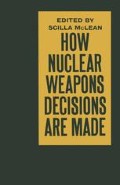Abstract
This chapter is organised according to the main influences on nuclear weapons decision-making in Britain. Although it starts with the Cabinet and Cabinet Office, the Cabinet is by no means the sole decision-maker on nuclear matters in Britain which many assume it to be. This will become clear as the respective influences of the British civil service structure, the Ministry of Defence itself, the Treasury and the Foreign and Commonwealth Office are discussed. Britain’s ‘special relationship’ with the US on the nuclear issue is clearly a major influence on decisions, and is dealt with next, followed by a brief examination of the importance of Britain’s role in NATO. The case-study chosen for this chapter describes decision-making on the Chevaline warhead, an improvement to the Polaris system undertaken in the late 1970s, and which became operational in 1982. This subject was chosen for two main reasons. It illustrates some of the influences on decision-making described in earlier sections, and much less has been written about it than about other British nuclear systems.
Access this chapter
Tax calculation will be finalised at checkout
Purchases are for personal use only
Preview
Unable to display preview. Download preview PDF.
Notes
What is known is largely due to the work of P. Hennessy, in his articles for The Times and in Cockerell, Hennessy and Walker, Sources Close to the Prime Minister (London: Macmillan 1984).
Cambridge University Disarmament Seminar, Defended to Death, G. Prins (ed.) (London: Penguin, 1983).
H. Young and A. Sloman, No Minister — an Enquiry into the Civil Service (BBC, 1982) pp. 62–4.
House of Commons Ninth Report of the Committee of Public Accounts, Chevaline Improvement to the Polaris Missile System (HMSO, Mar. 1982).
B. Sedgemore, The Secret Constitution (London: Hodder & Stoughton, 1980).
C. Bowie and A. Platt, British Nuclear Policy Making (Rand Publications Services, Jan. 1984) R-3085-AF.
R. Angus, The Organisation of Defence Procurement and Production in the UK. Aberdeen Studies in Defence Economics no. 13 (Dec. 1979);
and L. Freedman, Arms Production in the UK- Problems and Prospects, Royal Institute of International Affairs (London, 1978).
D. Campbell, ‘Inside the Sigint Empire’ New Statesman (29 Oct. 1982)
‘Unaccountable Empire Building’, New Statesman (19 Nov. 1982)
and ‘Friends and Others’ New Statesman (26 nov. 1982).
B. Taylor, ‘Coming of Age — MoD Evaluation 1974–82’, RUSI Journal, Sept. 1983;
and The Central Organisa-Hon For Defence, Cmnd 9315 (HMSO, July 1984).
P. Rogers, Guide to Nuclear Weapons (Bradford School of Peace Studies, 1984).
Lord Zuckerman ‘Scientists, Bureaucrats and Ministers’ in Proceedings of the Royal Institution of Great Britain, vol. 56. (1984) p. 223.
House of Commons Ninth Report from the Public Accounts Committee 1981–2, MoD Chevaline Improvement to the Polaris Missile (HMSO, 1982).
House of Commons Defence Committee Fourth Report 1980–1, Strategic Nuclear Weapons Policy (HMSO, 1981).
A. Milne, ‘The Malvern Link’, The Listener (10 May 1984).
House of Commons Second Report from the Defence Committee, Ministry of Defence Organisation and Procurement, 22–11 (HMSO, June 1982).
C. Bowie and A. Platt, op. cit.
H. Heclo and A. Wildavsky, The Private Government of Public Money: Community and Policy Inside British Politics (University of California Press, Berkeley, 1974) pp. 49–50.
N. Simms, ‘The Arms Control and Disarmament Policy Process in Britain’, in H. Gunter Brauch, D. Clarke (eds), Decision-Making for Arms Limitation: Assessments and Prospects (Cambridge: Ballinger, 1983) p. 115.
Sir M. Perrin, who was present, The Listener (7 Oct. 1982).
Bowie and Platt, op. cit., p. 76.
J. Simpson, The Independent Nuclear State (London: Macmillan, 1983).
D. Campbell, The Unsinkable Aircraft Carrier (London: Michael Joseph, 1984).
P. Malone, The British Nuclear Deterrent (New York: Croom Helm, 1984), p. 69.
P. Malone, op. cit., p. 72.
F. Pym (UK Defence Secretary), introduction, Britain’s Future Strategic Nuclear Deterrent Force, Defence Open Government Document 80/23 (MoD, July 1980).
House of Commons Committee of Public Accounts Ninth Report Session 1981–2, Ministry of Defence Chevaline Improvement to the Polaris Missile System, HC269 (1982) q. 130.
L. Freedman, Britain and Nuclear Weapons (London: Macmillan 1980) p. 45.
House of Commons Fourth Report from the Defence Committee Session 1980–1, Strategic Nuclear Weapons Policy. HC36, 1981, BAeD Memorandum, p. 183.
L. Freedman, op. cit., p. 54.
P. Malone, op. cit., p. 21.
For a recent review of Galosh improvement see R. Hutchinson, ‘CHEVALINE: UKs Response to Soviet ABM System’, Jane’s Defence Weekly, 15 Dec. 1984.
L. Freedman, op. cit., p. 55.
Author information
Authors and Affiliations
Editor information
Copyright information
© 1986 Oxford Research Group
About this chapter
Cite this chapter
Beyer, J. et al. (1986). Britain. In: McLean, S. (eds) How Nuclear Weapons Decisions are Made. Palgrave Macmillan, London. https://doi.org/10.1007/978-1-349-18081-3_3
Download citation
DOI: https://doi.org/10.1007/978-1-349-18081-3_3
Publisher Name: Palgrave Macmillan, London
Print ISBN: 978-0-333-40583-3
Online ISBN: 978-1-349-18081-3
eBook Packages: Palgrave Political & Intern. Studies CollectionPolitical Science and International Studies (R0)

